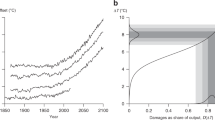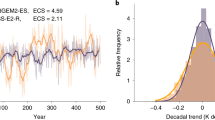Abstract
The small but stubbornly unyielding possibility of a very large long-term response of global temperature to increases in atmospheric carbon dioxide can be termed the fat tail of high climate sensitivity. Recent economic analyses suggest that the fat tail should dominate a rational policy strategy if the damages associated with such high temperatures are large enough. The conclusions of such analyses, however, depend on how economic growth, temperature changes, and climate damages unfold and interact over time. In this paper we focus on the role of two robust physical properties of the climate system: the enormous thermal inertia of the ocean, and the long timescales associated with high climate sensitivity. Economic models that include a climate component, and particularly those that focus on the tails of the probability distributions, should properly represent the physics of this slow response to high climate sensitivity, including the correlated uncertainty between present forcing and climate sensitivity, and the global energetics of the present climate state. If climate sensitivity in fact proves to be high, these considerations prevent the high temperatures in the fat tail from being reached for many centuries. A failure to include these factors risks distorting the resulting economic analyses. For example, we conclude that fat-tail considerations will not strongly influence economic analyses when these analyses follow the common—albeit controversial—practices of assigning large damages only to outcomes with very high temperature changes and of assuming a significant baseline level of economic growth.





Similar content being viewed by others
Notes
Note that in all cases ΔT is measured in °C, and so the units of α and β depend on the choice of exponents. This could be avoided by dividing T by a normalizing temperature.
References
Allen MR et al (2006) Observational constraints on climate sensitivity. In: Schellnhuber HJ (ed) Avoiding dangerous climate change. Cambridge University Press, Cambridge, U.K.
Annan JD, Hargreaves JC (2006) Using multiple observationally-based constraints to estimate climate sensitivity. Geophys Res Lett 33:L06704. doi:10.1029/2005GL025259
Annan JD, Hargreaves JC (2009) On the generation and interpretation of probabilistic estimates of climate sensitivity. Clim Change. doi:10.1007/s10584-009-9715-y
Armour K, Roe GH (2011) Climate commitment in an uncertain world. Geohpys Res Lett 38. doi:10.1029/2010GL045850
Arrhenius S (1896) On the influence of carbon acid in the air upon the temperature of the ground. Philosoph Mag 41:237–276
Baker MB, Roe GH (2009) The shape of things to come: why is climate change so predictable? J Climate 22:4574–4589
Charney JG (1979) Carbon dioxide and climate: a scientific assessment. National Academy of Science, p 22
Colman R, McAvaney B (2009) Climate feedbacks under a very broad range of forcing. Geophys Res Lett 36. doi:10.1029/2008GL036268
Gregory JM (2000) Vertical heat transports in the ocean, and their effects on time-dependent climate change. Clim Dyn 16:501–515
Forest CE, Stone PH, Sokolov AP, Allen MR, Webster MD (2002) Quantifying uncertainties in climate system properties with the use of recent climate observations. Science 295:113–117
Hansen J, Russell G, Lacis A, Fung I, Rind D, Stone P (1985) Climate response times: dependence on climate sensitivity and ocean mixing. Science 229:857859
Held IM, Winton M, Takahashi K, Delworth T, Zeng F, Vallis GK (2010) Probing the fast and slow components of global warming by returning abruptly to preindustrial forcing. J Climate 23:2418–2427
Interagency Working Group on Social Cost Carbon (2010) Technical support document: social cost of carbon for regulatory impact analysis under executive order 12866. Available at www.epa.gov/otaq/climate/regulations/scc-tsd.pdf
IPCC (2007) Physical science basis. Contribution of working group I to the fourth assessment report of the intergovernmental panel on climate change. Cambridge Univ. Press
Knutti R, Stocker TF, Joos F, Plattner G-K (2002) Constraints on radiative forcing and future climate change from observations and climate model ensembles. Nature 416:719–723
Knutti R, Hegerl GC (2008) The equilibrium sensitivity of the Earth’s temperature to radiation changes. Nat Geosci 1(11):735–743
Knutti R, Furrer R, Tebaldi C, Cermak J, Meehl GA (2010) Challenges in combining projections from multiple climate models. J Climate 23:2739–2758
Millner A (2011) On welfare frameworks and catastrophic climate risks. Philosophy & Methodology of Economics. doi:10.2139/ssrn.1799481
Nordhaus WD (2008) A question of balance: economic modeling of global warming. Yale Press
Raper SCB et al (2001) Use of an upwelling-diffusion energy balance climate model to simulate and diagnose A/OGCM results. Clim Dyn 17:601613
Roe GH, Baker MB (2007) Why is climate sensitivity so unpredictable? Science 318:629–632
Roe GH (2009) Feedbacks, time scales, and seeing red. Annu Rev Earth Planet Sci 37:93–115
Roe GH (2010) Knowability and no ability in climate change projections. National center for environmental economics report no. 0564. Available at http://yosemite.epa.gov/ee/epa/eerm.nsf/vwAN/EE-0564-117.pdf
Roe GH, Armour KC (2011) How sensitive is climate sensitivity? Geophys Res Lett 38. doi:10.1029/2011GL047913
Solomon S et al (2010) Climate stabilization targets: emissions, concentrations and impacts over decades to millennia. National Research Council, National Academy of Sciences
Stainforth DA, Aina T, Christensen C, Collins M, Faull N, Frame DJ, Kettleborough JA, Knight S, Martin A, Murphy JM, Piani C, Sexton D, Smith LA, Spicer RA, Thorpe AJ, Allen MR (2005) Uncertainty in predictions of the climate response to rising levels of greenhouse gases. Nature 433:403–406
Weitzman ML (2009a) Additive damages, fat-tailed climate dynamics, and uncertain discounting. Economics 3:2009–39
Weitzman ML (2009b) On modeling and interpreting the economics of catastrophic climate change. Rev Econ Stat 91:1–19
Weitzman ML (2010) GHG targets as insurance against catastrophic climate damages discussion paper 2010-42. Harvard Project on International Climate Agreements, Cambridge, Mass.
Wigley TML, Schlesinger ME (1985) Analytical solution for the effect of increasing CO2 on global mean temperature. Nature 315:649–652
Acknowledgements
We are very grateful to Marcia Baker and Marshall Baker for conversations and comments that are central to this work; and without implying agreement, to Marty Weitzman and Antony Millner for guidance and advice, to Simon Dietz, Charles Mason, Steve Newbold, and Alex Marten for instructive feedback; finally we are grateful to three reviewers for thoughtful and constructive reviews that substantially improved the manuscript, and to Gary Yohe, the editor.
Author information
Authors and Affiliations
Corresponding author
Rights and permissions
About this article
Cite this article
Roe, G.H., Bauman, Y. Climate sensitivity: should the climate tail wag the policy dog?. Climatic Change 117, 647–662 (2013). https://doi.org/10.1007/s10584-012-0582-6
Received:
Accepted:
Published:
Issue Date:
DOI: https://doi.org/10.1007/s10584-012-0582-6




